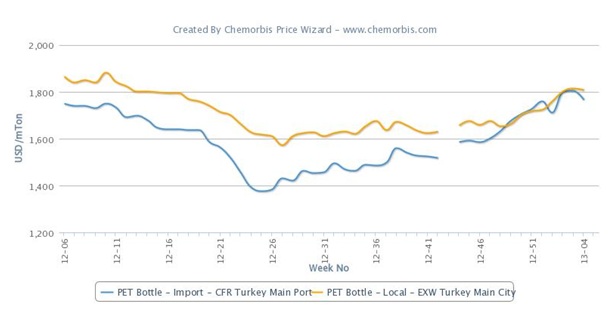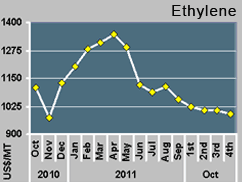The ethylene spot market traded lower this week while the propylene spot market was higher. NGLs were mostly lower and benzene was range-bound. Spot resin prices moves higher as inventories dwindled and demand picked up both domestically and internationally.
OLEFINS
Spot ethylene prices slid this week. April traded Tuesday at 24.125 cpp in the Equistar system. In the Williams system, April traded Wednesday at 23.75 cpp, and on Thursday at 23.5 cpp. Prices are down from spot deals done a week earlier at 24.5 cpp, but down sharply from end-February levels of 33 cpp.
In the contract market, initial agreements were made to reduce the March NTP price by 1 cpp, but this has not been reported as market-wide. Feb settled at 32 cpp.
Polymer grade propylene traded twice this week at 26.5 cpp for April. This is up from the last April PGP deal of 25.5 cpp, done on March 26. Refinery grade propylene traded Wednesday at 21.125 cpp and Thursday at 23.375 cpp, both for April pipeline delivery. Friday, April traded at 22 cpp and 22.625 cpp, both for pipeline delivery. A week earlier, RGP for confirmed pipeline delivery was trading around 20.5 cpp. Spot prices are down from end-February levels of 24.25-24.5 cpp. Gulf coast alky values were about 6 cents above spot RGP prices for most of the week, while RGPā?Ts implied value in cumene was about 6 cents below RGP spot prices.
Contract prices for April polymer and chemical grade propylene remained under discussion this week. Producers have nominated increases of 1-3 cpp. March settled a penny higher at 29 cpp for PGP and 27.5 cpp for CGP.
In production news, Formosa’s olefins 2 cracker at Point Comfort shut Wednesday to make minor repairs to the cooling system. The unit is expected to resume operations on April 8. ExxonMobil’s Beaumont olefins unit remains shut and a restart date has not been disclosed. One of Dow’s St. Charles crackers remains shut; a restart date has not been disclosed. Shell’s GO-1 cracker is expected to restart in mid-to-late April.
In industry news, Solutia said it reached an agreement to sell its Nylon business to an affiliate of SK Capital Partners. The sale includes Solutia’s Chocolate Bayou facility, which manufactures acrylonitrile among other products. Chemical grade propylene is a key raw material in producing acrylonitrile.
POLYETHYLENE
Spot polyethylene prices were higher this week. Producers raised offering prices in support of their renewed price increase effort, and buyers raised bids amid tighter supply. Spot domestic prices added about 1 cpp while export prices jumped 2-3 cpp, spurred by active Chinese buying, supported by their recent government tax incentives.
Producers had been seeking to implement a 5-cent increase in March, on the heels of a 7-cent increase that was reportedly implemented in January and February. Ultimately, market participants said an agreement was reached to keep prices flat. Producers are now seeking to implement the 5-cent increase in April. Processors have expressed doubt that this will be implemented.
While February was an active month in terms of processor purchasing overall domestic demand did not improve, participants said. Orders were off in March and inventories were lean at all levels of the chain going into April. This week saw good domestic interest from processors in need of material, but some traders said they were unwilling to add to inventories at higher prices. The recent surge in exports has helped to soak up surplus inventories. Export prices have increased more than domestic prices, creating competition for available spot material.
Spot PE prices were higher this week. HDPE blow mold was steady in the low 40s cpp range. HDPE injection and LLDPE film butene prices were about a half-cent higher in the low-to-mid 40s cpp range. LDPE film clarity was also about a half-cent higher in the high 40s cpp-to-low 50s cpp range. Spot prices ended the month about 1.5 cents below end-February levels.
Spot market offers have dwindled as material is being sent overseas and producers continue to keep their inventories light, limiting what is released into the spot market. The Plastics Exchange spot trading floor had about 2 million pounds of HDPE blow mold and HDPE injection offered each day this week. About 1 million pounds of LDPE film and LLDPE film was offered each day.
Although overall spot export demand from Mexico and South America continues below 2008 pace, aggressive Chinese buying has lifted all export sales prices, and are even bumping up against domestic spot prices.
POLYPROPYLENE
Spot polypropylene prices jumped about 2 cpp this week amid a bump in domestic and export demand and a decline in supplies. Few fresh generic prime cars were shown to the market. Exporters came to the market and cleaned up much of the unsold trader-owned material that had been lingering in Houston warehouses.
Contract PP prices were about a penny higher in March in line with the increase in propylene monomer contract prices. April discussions continue as market participants await a settlement for polymer grade propylene. Producers are seeking a 3-cent increase for April PP.
Polypropylene trading activity was swift this week, and aggressive buying has pushed spot prices up a couple cents, traders said. Most of the spot transactions seen were in the mid-high 30s cpp for HoPP and the high 30s cpp to low 40s cpp range for CoPP. Inventories have become snug, as processors, who have maintained lean stocks, stepped in to buy more material. Spot PP purchases have also been stimulated by a bump in propylene monomer spot prices this week and worries about securing supply for April in that arena. Spot prices ended the month about 1.5 cents above end-February levels.
The Plastics Exchange spot trading floor had about 1 million pounds of HoPP and CoPP offered each day this week.
Export demand for PP has played a key role in pushing spot prices higher this week. There was a light-normal flow to Latin America and Mexico, but a surge to China.
POLYSTYRENE
Polystyrene spot prices were about 2 cpp higher this week as producers raised spot offering prices in support of April price increases. PS producers, pressured by rising Benzene costs, have issued a 2 cpp increase for April 1 and 4 cpp for April 15.
While overall PS offers remains limited, a few railcars of GPPS were offered in the high 40s cpp and HIPS was available in the low-to-mid 50s cpp range. The Plastics Exchange spot trading floor had about 1 million pounds of GPPS offered each day this week and 600,000 pounds of HIPS offered.
BENZENE
Spot prices were range-bound for much of the week. March trading was done and April/May was the market’s focus. April closed Monday at 166-170 cpg DDP, at 168-172 cpg DDP Wednesday and closed the week at 175-180 cpg DDP. April benzene closed last week at 169-172 cpg. May’s spot market ideas were near parity to April this week. April contracts were settled at 169 cpg, up considerable from the March contract price of 129 cpg.
Spot benzene prices saw significant gains during March, suported by robust export demand and higher energy prices. A month ago, March was trading at 115-119 cpg and April was at 118-124 cpg. Benzene’s average spot price in March was 133.23 cpg, or 18.07 cpp, which is slightly lower than Feb’s average price of 137.932 cpg, or 18.707 cpp.
NGLs
Ethane: Prices were up slightly this week. Markets closed at 31.75 cpg on Monday and at 33.75 on Wednesday before ending the week at 34.75 cpg. Ethane closed last week at 32.25 cpg. Ethane’s comparitively low price to other NGLs
has kept it popular as a cracker feedstock. Ethane’s average price in March was 33.9375 cpg, or 11.427 cpp, which is slightly lower from its Feb average price of 35.842 cpg, or 12.068 cpp.
Propane: Prices eased this week. Propane closed at 64 cpg Monday, at 62 cpg Wednesday and closed the week at 65.25 cpg, compared with 68.125 cpg the previous Friday. Propane/propylene inventories increased last week by 0.7 million barrels and are above the upper limit of the average range, the EIA reported Wednesday. Propane’s average price in March was 65.392 cpg, or 15.459 cpp, which is nearly unchanged from its Feb average price of 65.533 cpg, or 15.492 cpp.
Butane: Prices fell this week. Butane closed Monday 82.75 cpg cpg, and at 80.75 cpg on Wednesday. It closed at 85.5 cpg on Friday, compared with 87 cpg the previous Friday. Isobutane’s premium to normal butane remained wide, at more than 15 cpg most days this week, supported by continued demand for its use in alkylate production. Butane’s average price in March was 81.682 cpg, or 16.772 cpp, which is slightly lower than its Feb average price of 87.322 cpg, or 17.931 cpp.
Natural gasoline: Prices were lower this week. Natural gasoline closed at 101.75 cpg Monday, at 101 cpg Wednesday and ended the week at 109 cpg, compared with 108.75 cpg the previous Friday. It remained a relatively unpopular feedstock, but the uptick in spot propylene prices somewhat muted its downside. Natural gasoline prices averaged 100.892 cpg in March, or 18.214 cpp, which is up slightly from Feb’s average price of 97.671 cpg or 17.633 cpp.
ENERGY
Crude oil futures were down for much of the week, but rebounded by its end. May crude settled at $48.41/bbl Monday, at $48.39/bbl Wednesday and ended the week at $52.51/bbl, compared with $52.38/bbl the previous Friday. April contracts expired Mar 20 at $51.06/bbl.
US crude oil refinery inputs averaged 14.2 million barrels per day during the week ending March 27, up 23,000,000 barrels per day from the previous week’s average, the EIA reported Thursday. Refineries operated at 81.7% last week, up slightly from the previous week’s rate of 81.2%. Gasoline production increased last week, averaging 8.7 million bpd.
Natural gas prices saw mild gains this week. May moved into the front-month futures contract position Monday, and settled at $3.739/mmBtu Monday. They settled at $3.695/mmBtu Wednesday and $3.801/mmBtu Friday. April contracts expired at $3.631/mmBtu the previous Friday.
Working gas in storage was 1,654 Bcf as of March 27, according to EIA estimates released Thursday, unchanged from the previous week.
Source: petrochemwire.com






